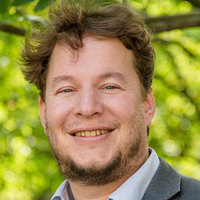Christian Joas
University of Copenhagen, Niels Bohr Archive, Faculty Member
- History of Science, History and Philosophy of Physics, Philosophy of Science, History of Physics, Materials Science, Theoretical Physics, and 11 moreCondensed Matter Physics, Quantum Chemistry, Theoretical Condensed Matter Physics, Historiography, Early Modern History, History, Foundations of Quantum Mechanics, Philosophy of Chemistry, Mechanistic Explanation, Philosophy of Physics, and History of Science and Technologyedit
Research Interests:
Research Interests:
Research Interests:
Arnold Sommerfeld (1868–1951), one of the founders of modern theoretical physics and a pioneer of quantum theory, was no condensed matter physicist. He nevertheless played a crucial role for the history of the field. Besides his important... more
Arnold Sommerfeld (1868–1951), one of the founders of modern theoretical physics and a pioneer of quantum theory, was no condensed matter physicist. He nevertheless played a crucial role for the history of the field. Besides his important contributions to the study of condensed matter systems, among which his seminal electron gas theory of metallic conduction probably stands out, he influenced the field through his very approach to science, through his way of “doing” physics. Sommerfeld’s specific style permeated not only his research but also his teaching and his promoting of physics. This has had a lasting influence on the practices of physicists to this day, and not only, but importantly, on those of condensed matter physicists. This article aims to provide a concise account of Sommerfeld’s influence on the study of condensed matter systems, with regard to both his research and his practice.
Research Interests:
Research Interests:
with Johannes Knolle
Research Interests:
Der zweite Weltkrieg und der Kalte Krieg veränderten nicht nur das Verhältnis zwischen Militär, Industrie und Wissenschaft, sondern auch die wissenschaftli- che Praxis von Physikern und anderen Wissenschaftlern. In den 1950er Jahren... more
Der zweite Weltkrieg und der Kalte Krieg veränderten nicht nur das Verhältnis zwischen Militär, Industrie und Wissenschaft, sondern auch die wissenschaftli- che Praxis von Physikern und anderen Wissenschaftlern. In den 1950er Jahren stellte die Entwicklung von ...
Research Interests:
ABSTRACT Voici un siècle, la découverte de la supraconductivité fut le fruit d'une politique déterminée des Pays-Bas de soutien à la recherche et l'enseignement pour maintenir leur rang, et de... more
ABSTRACT Voici un siècle, la découverte de la supraconductivité fut le fruit d'une politique déterminée des Pays-Bas de soutien à la recherche et l'enseignement pour maintenir leur rang, et de l'obstination d'un élève de Van der Waals, Heike Kamerlingh Onnes, qui ...
Research Interests:
Research Interests:
Research Interests:
Research Interests:
Research Interests:
Research Interests:
Research Interests:
Assuming the exchange of antiferromagnetic spin fluctuations as the Cooper pairing mechanism we calculate the doping dependence of the resonance peak seen in inelastic neutron scattering and the magnetic coherence effect. We find that the... more
Assuming the exchange of antiferromagnetic spin fluctuations as the Cooper pairing mechanism we calculate the doping dependence of the resonance peak seen in inelastic neutron scattering and the magnetic coherence effect. We find that the resonance peak in the magnetic susceptibility, Im χ(q,ω), appears only in the superconducting state at ωres and that it scales with Tc. Magnetic coherence is a result of an interplay between a d-wave order parameter and the kinematic gap ω0. We analyze the structure of Im χ below Tc, the doping dependence of ω0 and ωres, and the consequences for the optical conductivity.
Research Interests:
Assuming the exchange of antiferromagnetic spin fluctuations as the Cooper pairing mechanism we calculate the doping dependence of the resonance peak seen in inelastic neutron scattering and the magnetic coherence effect. We find that the... more
Assuming the exchange of antiferromagnetic spin fluctuations as the Cooper pairing mechanism we calculate the doping dependence of the resonance peak seen in inelastic neutron scattering and the magnetic coherence effect. We find that the resonance peak in the magnetic susceptibility, Im χ(q,ω), appears only in the superconducting state at ωres and that it scales with Tc. Magnetic coherence is a result of an interplay between a d-wave order parameter and the kinematic gap ω0. We analyze the structure of Im χ below Tc, the doping dependence of ω0 and ωres, and the consequences for the optical conductivity.
Research Interests:
Research Interests:
Research Interests:
The publication of Thomas S. Kuhn’s "Structure of Scientific Revolutions" in 1962 stands for a turning point in the history and philosophy of science. The repercussions of this work have rearticulated the theoretical framework of history... more
The publication of Thomas S. Kuhn’s "Structure of Scientific Revolutions" in 1962 stands for a turning point in the history and philosophy of science. The repercussions of this work have rearticulated the theoretical framework of history and philosophy of science and have also generated discussions that contributed to the formation of the communities of historians as well as philosophers of science in many parts of the world. Different approaches to history of science have since emerged and most of them have the "Structure" as their reference point. In October 2012, a conference at the Max Planck Institute for the History of Science brought together some of the historians of science whose work has played a decisive role in the ways history of science has evolved as a field of research in the past 50 years, both intellectually and institutionally. This volume gathers reflections by many of these historians on the history of the history of science, based on the presentations and discussions at the conference. The topics covered range from personal recollections of working with Thomas Kuhn to broad overviews of the historical development of the history of science as a discipline in the past half-century. The series Proceedings of the Max Planck Research Library for the History and Development of Knowledge presents the results of scientific meetings on current issues and supports further cooperation on these issues via an electronic platform. The volumes are available both as print-on-demand books and as open-access publications on the Internet. The material is freely accessible online at www.edition-open-access.de.
